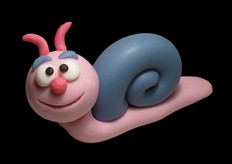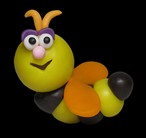Which plasticine is best ?
This question is a difficult one to answer because there are so many different brands available. It may be worth trying a small amount of different types
before buying more. In general, when working with young children, I like plasticine based on bee's wax, it has a nice texture and the colours are generally bright. Plasticine based on bee's
wax also tends to have more stable pigments, meaning that the colours won't rub off on your hands.
Which tools do I need ?
The best tools are your imagination and those things at the end of each arm. I made all the characters on this page using just my hands and a blunt pencil to
poke holes for the nose. Things like a flat work surface, some stiff card (used to cut straight edges) and matchsticks can be handy as well, but no one should think they need lots of fancy
tools before they can start.
What does "never too early to start" mean ?
Children as young as three can have fun with plasticine, although at this age it's more about the tactile sensation of playing with "funny squishy stuff".
Obviously no one should expect a three year old to start modeling the figures on this page. From ages four to six, and with some help and guidance, children can start to make approximations
of the figures seen here.
Is there a particular approach to modeling suited to children ?
Yes, it's a method promoted by the well known stop-motion animator Rony Oren. Using this approach, each character is made from a combination of three basic
forms, these being: the ball, the circle and the sausage! In fact, even the circle and sausage start of life as a ball. The ball is then elongated to form a sausage (or an oval or a cone), or
flattened to form a circle, and so on. Being able to form a good ball means you're already half way there!
Interesting facts about Plasticine
Although in the U.K "Plasticine" is commonly used as a generic term for modeling clay, it is in fact a brand name. It was invented around 1897 by the
Englishman William Harbutt, and as far as I know, can still be purchased under the name "Harbutts Plasticine". I haven't used it myself so I can't say what it's like, but according to some
sources it was used by Nick Park for his "Wallace and Gromit" films.
Because I travel regularly between Berlin and Magdeburg, I can offer lessons in both cities (in English or German). If you know a school or kindergarten that
might be interested, give me a ring and I'll do my best to help.
Below are a few common questions.
Some good reasons to start modeling are that it trains the eye, improves the fine motor skills of the hands, and promotes creativity. However, The best
reason is, because it's fun!
Having fun when learning something new is particularly important for children who might otherwise lose interest. The good thing about sculpting is that in
most cases, there's no "right" or "wrong" way of doing it, you simply start by letting your fantasy out of the box.
Of course, when creating characters such as the ones on this page, there are certain tips and tricks that can help, but these are things that anyone can
learn. (With time and practice).
The models made by children will look different to the ones I've made here, and that's normal. The primary goal is not to teach children how to copy a figure,
but to let them have fun creating their own.
It's never too early to start sculpting! (Or too late for that matter).
Copyright 2009 www.kleinplastik.com Skulptur und Plastik in Berlin All rights reserved.
K l e i n p l a s t i
k . c o m














